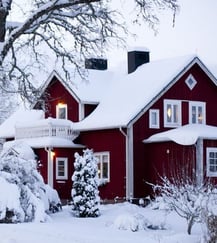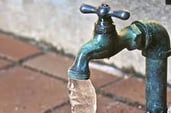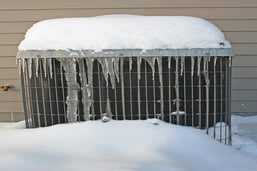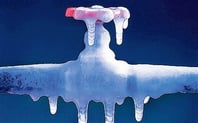Cold weather is just a part of life in Central Indiana! If you are wondering how to stay warm and cozy this winter season and keep your home running efficiently, check out the list of winterizing tips our Joyner Homes team has  compiled. These are a few DIY ideas that won’t break the bank when it comes to preparing your home for winter weather.
compiled. These are a few DIY ideas that won’t break the bank when it comes to preparing your home for winter weather.
- Reverse Ceiling Fans: Did you know that changing the direction of your ceiling fan can have an impact on the energy you use in the winter?
During the summer months, it’s recommended to let your fans spin counter-clockwise to push cool air downward. During winter, allow your fans to spin in the opposite direction to pull air in the room upwards, which pushes warm air down the sides of a room. This results in a room that is a little bit warmer and can give your heating unit a much-needed break by simply pushing a button on your fan motor.

- Winterize Outside Faucets: Don’t forget your outside water faucets! Make sure to disconnect garden hoses and drain any leftover water in the pipes.
- Not all Fires Are Cozy: Winter is the worst season for house fires. One of your winterizing steps should be changing the batteries in your smoke and carbon monoxide alarms. Make sure you also test your alarms and check that they’re up to date — alarms and fire extinguishers should be replaced every 10 years.
If you have a fireplace or wood stove, you should have your chimney inspected once a year, and, if necessary, cleaned to remove soot and creosote (a sticky, combustible residue that’s produced when wood is burned). Creosote buildup can result in a chimney fire. Because poor drafts cause the buildup to happen faster, consider putting a cap on your chimney to keep debris from blocking your flue.
- Take Care Of The Pipes: During the winter months, it’s fairly easy to end up with frozen pipes. Keeping water moving through the pipes by allowing the faucets to lightly drip is one way to prevent an indoor water park. Another option is to insulate the water pipes in unheated areas of your house.
Kitchen and bathroom cabinets can be surprisingly cold, especially if they’re along an outside wall, so consider wrapping those pipes as well, or keep the cabinets open so the warm air can circulate around them.
- Because Heat Isn’t Cheap: While it’s best to be cautious about maintaining the heat within your home, don’t go crazy with it. Practice money saving techniques like slightly lowering your water heater temperature or opening your curtains to let sunlight naturally bring in warmth. An indoor temperature of 68 degrees seems to be com
 fortable for most and don’t be afraid layer up a little with a warm sweater. We recommend that you don’t leave the home or any room without heat during the cold weather and don’t set your thermostat below 55 degrees. Some homeowners have made it a habit to lower their thermostat a couple of degrees when they aren’t home and when they are sleeping. For every degree you lower the thermostat, you’ll end up saving 1-3% of your heating bill. That doesn’t seem like much but you could save hundreds of dollars each year.
fortable for most and don’t be afraid layer up a little with a warm sweater. We recommend that you don’t leave the home or any room without heat during the cold weather and don’t set your thermostat below 55 degrees. Some homeowners have made it a habit to lower their thermostat a couple of degrees when they aren’t home and when they are sleeping. For every degree you lower the thermostat, you’ll end up saving 1-3% of your heating bill. That doesn’t seem like much but you could save hundreds of dollars each year.
- Staying Cool In The Summer Starts During The Winter: Central air conditioning is a great feature to have in a home during the hot and humid Indiana summers, but it can also be fairly expensive to repair if it’s not properly winterized.
The first step to properly winterizin g your central air conditioning is to make sure all debris is cleared away from the unit. (sticks, leaves, and bushes)
g your central air conditioning is to make sure all debris is cleared away from the unit. (sticks, leaves, and bushes)
Next, cover the unit with a piece of wood that’s large enough to cover the top of the unit. This will prevent debris, leaves, or even worse, icicles fall inside the unit which can create damage.
If your central air conditioning unit has an electric box next to it, switched to the off position. Many people believe you should cover the entire unit, but this is actually not recommended. Covering the entire unit can trap moisture inside and lead to serious problems.
If you experience frozen pipes, here are some helpful hints to safely defrost the piping. (Freezing is more likely to occur near an outer wall that is exposed to winter winds.)
- Begin by restoring heat to the affected area
- Open all faucets connected to the pipeline so steam can escape during thawing.

- Begin thawing slowly at the frozen pint nearest the faucet. Thaw slowly to prevent formation of steam, which can cause pipes to rupture or burst. A Heat lamp set at least six inches from plaster
board or wall panel will thaw the pipes behind it. For exposed pipes, use hair dryer or rent a heat cable to wrap around the pipe. - If drain taps have been affected, pour hot water into the drain until thawed. Do not use boiling water! Pipes can crack from such a drastic temperature change.
Once you’ve finished winterizing your home, you can relax by the fire knowing you’re prepared no matter how cranky Old Man Winter gets this year!
CATEGORIES
- floor plan (5)
- custom homes (4)
- Home Features (3)
- completed homes (3)
- home building (3)
- joyner homes (3)
- Available Home (2)
- The Bedford (2)
- build on your lot (2)
- finished home (2)
- open house (2)
- custom home build (1)
- deer creek (1)
- duplex (1)
- event (1)
- interior design (1)
- neighborhoods (1)
- showcase homes (1)
- spring cleaning (1)
- the rockford (1)